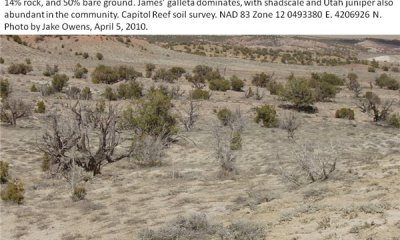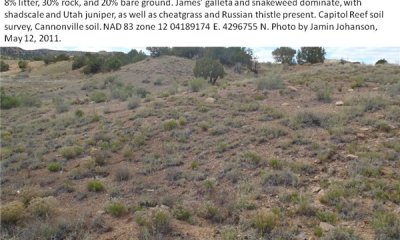
Semidesert Shallow Clay (Shadscale-Utah Juniper)
Scenario model
Current ecosystem state
Select a state
Management practices/drivers
Select a transition or restoration pathway
- Transition T1 More details
-
No transition or restoration pathway between the selected states has been described
Target ecosystem state
Select a state
Description
The reference state is dominated by shadscale, James' galleta, and Utah juniper. Other shrubs can are opportunistic on this site and can be more abundant than shadscale; including Bigelow sagebrush, Torrey's jointfir, snakeweed, and yellow rabbitbrush. These shrubs are not always found in the reference plant community, as opposed to shadscale which is always present.
The harsh soil environment of this site makes it reistant to invasion and wildfire. Not only is it difficult for invasive species to establish on the heavy shale soils, but the sparse native vegetation does not produce enough fuel to carry fires on a recurring basis. As a result, the reference state currently has but one documented plant community.
Submodel
Description
The invaded state is similar to the Reference state in community structure and ecological function, but non-native invasive species are present. Russian thistle and cheatgrass have been documented to establish on this site in the absence of major disturbance, but they constitute only a minor component of the plant community.
Submodel
Mechanism
This transition occurs when non-native invasive species establish in the community. Once a seed source and germination sites allow Russian thistle, cheatgrass, and/or other non-native invasive species to establish, they will persist in the community. Russian thistle and cheatgrass have been documented to establish on this site in the absence of major disturbance.
Model keys
Briefcase
Add ecological sites and Major Land Resource Areas to your briefcase by clicking on the briefcase (![]() ) icon wherever it occurs. Drag and drop items to reorder. Cookies are used to store briefcase items between browsing sessions. Because of this, the number of items that can be added to your briefcase is limited, and briefcase items added on one device and browser cannot be accessed from another device or browser. Users who do not wish to place cookies on their devices should not use the briefcase tool. Briefcase cookies serve no other purpose than described here and are deleted whenever browsing history is cleared.
) icon wherever it occurs. Drag and drop items to reorder. Cookies are used to store briefcase items between browsing sessions. Because of this, the number of items that can be added to your briefcase is limited, and briefcase items added on one device and browser cannot be accessed from another device or browser. Users who do not wish to place cookies on their devices should not use the briefcase tool. Briefcase cookies serve no other purpose than described here and are deleted whenever browsing history is cleared.
Ecological sites
Major Land Resource Areas
The Ecosystem Dynamics Interpretive Tool is an information system framework developed by the USDA-ARS Jornada Experimental Range, USDA Natural Resources Conservation Service, and New Mexico State University.


